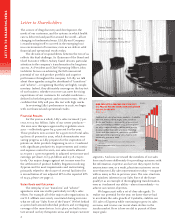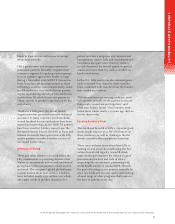Eli Lilly 2006 Annual Report Download - page 13
Download and view the complete annual report
Please find page 13 of the 2006 Eli Lilly annual report below. You can navigate through the pages in the report by either clicking on the pages listed below, or by using the keyword search tool below to find specific information within the annual report.
FINANCIALS
11
• In July 2006, we received FDA approval for Gemzar®
for the treatment of recurrent ovarian cancer in
combination with carboplatin. Additionally, the United
Kingdom’s National Institute for Health and Clinical
Excellence has recommended Gemzar coverage
under the UK’s National Health Service for the use of
Gemzar, in combination with paclitaxel, within a limited
population of breast cancer patients.
• In September 2006, we received an approvable letter
from the FDA for Arxxant™ for the treatment of diabetic
retinopathy. The FDA has indicated that it will require
effi cacy data from an additional Phase III study before
it will consider approving the molecule. We decided to
appeal the FDA’s decision and began discussions with
the agency. There can be no assurance that our appeal
will be successful.
• We submitted a supplemental NDA to the FDA for
Cymbalta for the treatment of generalized anxiety
disorder. We are also conducting Phase III studies on
Cymbalta for the treatment of fi bromyalgia, a chronic,
often debilitating pain disorder.
•
In January 2007, we licensed from OSI Pharmaceuticals,
Inc. (OSI), its glucokinase activator (GKA) program for
the treatment of type 2 diabetes, including the lead
compound PSN010. We received an exclusive license to
develop and market any compounds derived from the
GKA program. Under the terms of the agreement, we
paid an upfront fee of $25.0 million (pretax) (Note 3).
• In January 2007, along with our partner, Daiichi
Sankyo, we announced that we completed enrollment
in the TRITON study, a Phase III head-to-head study
comparing prasugrel to clopidogrel (Plavix®) in
patients with acute coronary syndrome undergoing
percutaneous coronary intervention (PCI).
Legal and Governmental Matters
In December 2006, the U.S. Court of Appeals for the
Federal Circuit affi rmed a district court ruling up-
holding the validity of our Zyprexa patent. We are very
confi dent we will maintain our U.S. patent protection on
Zyprexa until 2011.
We have reached agreements with claimants’ at-
torneys involved in U.S. Zyprexa product liability litigation
to settle a total of approximately 28,500 claims against
us relating to the medication. Approximately 1,300 claims
remain. As a result of our product liability exposures, the
substantial majority of which were related to Zyprexa, we
recorded net pretax charges of $1.07 billion in the second
quarter of 2005 and $494.9 million in the fourth quarter
of 2006.
In March 2004, we were notifi ed by the U.S. Attor-
ney’s offi ce for the Eastern District of Pennsylvania that
it had commenced a civil investigation relating to our U.S.
marketing and promotional practices.
In the United States, implementation of the Medicare
Prescription Drug, Improvement, and Modernization Act
of 2003 (MMA), which provides a prescription drug benefi t
under the Medicare program, took effect January 1, 2006.
In 2006, we experienced a one-time sales benefi t as a
result of MMA; however, in the long term there is addi-
tional risk of increased pricing pressures. While the MMA
prohibits the Secretary of Health and Human Services
(HHS) from directly negotiating prescription drug prices
with manufacturers, legislation was passed in early 2007
by the U.S. House of Representatives that would require
HHS to negotiate directly with pharmaceutical manufac-
turers. This legislation will be considered by the U.S. Sen-
ate. MMA retains the authority of the Secretary of HHS to
prohibit the importation of prescription drugs. Legislation
to allow for broad-scale importation has been presented
to both the House of Representatives and the Senate. The
proposed legislation could remove that authority and al-
low for the importation of products into the U.S. If adopted,
such legislation would likely have a negative effect on our
U.S. sales. Current importation language allows for medi-
cation to be carried in person from Canada to the U.S. and
does not authorize mail or Internet importation. Further,
the language disallows certain medications including
injectibles. We believe the expanded prescription drug
coverage for seniors under the MMA has further allevi-
ated the perceived need for a federal importation scheme.
However, notwithstanding the federal law that continues
to prohibit all but the very narrow drug importation de-
tailed above, several states have implemented importation
schemes for their citizens, usually involving a website that
links patients to selected Canadian pharmacies.
The successful implementation of the MMA may re-
lieve some state budget pressures but is unlikely to result
in reduced pricing pressures at the state level. A majority
of states have implemented supplemental rebates and
restricted formularies in their Medicaid programs, and
these programs are expected to continue in the post-MMA
environment. Moreover, under the 2005 federal Defi cit
Reduction Act, states will have greater fl exibility to impose
new cost-sharing requirements on Medicaid benefi ciaries
for non-preferred prescription drugs that will result in
02 03 04 05 06
GROWTH RATE IN NET SALES PER
EMPLOYEE INCREASES AT A FASTER RATE
THAN SALES GROWTH
($ dollars)
In 2006, we continued our focus on productivity,
led by an expanding team of Six Sigma black
belts. Net sales per employee increased 10
percent to $378,000, exceeding our net sales
growth in 2006 of 7 percent.
$378,000
$344,000
$311,000
$280,000
$258,000
























